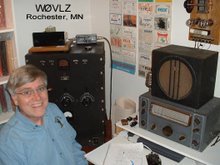I've finished wiring my 1934

transmitter, powered it up and it works! With about 300 volts

on the plates of the 46s

and the 47 it loads to 15-20 watts input and 7-10 watts output. It sounds great also.
One change I made from the Bill Orr design is to connect the 47 screen to regulated 150V rather than a resistor network off of B+.
This transmitter is not without some personality, though. Only the amplifier stage is keyed so the oscillator stage runs continuously. On key up any energy from the oscillator that makes it to the antenna will be heard as a faint back wave. We'll see if this is objectionable. The second personality trait is, unfortunately, pretty nasty. When using the rig, two phone jacks are for metering plate current and the third is for the key. If in the heat of the moment I get the three mixed up and plug the key into a metering jack I'll have over 300 volts on my key. To make matters even worse, keying the metering/B+ line works so I may not even be aware of what I've done until I get myself between the key and ground. I'm planning something that will keep me from accidentally removing the key plug.
Eventually I plan is to mate this transmitter with my
National FB7X for a complete 1934 station that I'll use in the 2010 AWA Linc Cundall OT CW Contest.


























